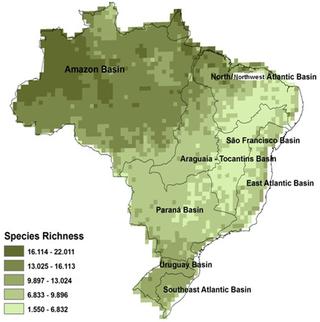PLOS ONE ( IF 3.7 ) Pub Date : 2018-09-19 , DOI: 10.1371/journal.pone.0204114 Thiago Bernardi Vieira , Carla Simone Pavanelli , Lilian Casatti , Welber Senteio Smith , Evanilde Benedito , Rosana Mazzoni , Jorge Iván Sánchez-Botero , Danielle Sequeira Garcez , Sergio Maia Queiroz Lima , Paulo Santos Pompeu , Carlos Sérgio Agostinho , Luciano Fogaça de Assis Montag , Jansen Zuanon , Pedro De Podestà Uchôa de Aquino , Mauricio Cetra , Francisco Leonardo Tejerina-Garro , Luiz Fernando Duboc , Ruanny Casarim Corrêa , María Angélica Pérez-Mayorga , Gabriel Lourenço Brejão , Nadayca Thayane Bonani Mateussi , Míriam Aparecida de Castro , Rafael Pereira Leitão , Fernando Pereira de Mendonça , Leandra Rose Palheta da Silva , Renata Frederico , Paulo De Marco

|
Several hypotheses are used to explain species richness patterns. Some of them (e.g. species-area, species-energy, environment-energy, water-energy, terrestrial primary productivity, environmental spatial heterogeneity, and climatic heterogeneity) are known to explain species richness patterns of terrestrial organisms, especially when they are combined. For aquatic organisms, however, it is unclear if these hypotheses can be useful to explain for these purposes. Therefore, we used a selection model approach to assess the predictive capacity of such hypotheses, and to determine which of them (combined or not) would be the most appropriate to explain the fish species distribution in small Brazilian streams. We perform the Akaike’s information criteria for models selections and the eigenvector analysis to control the special autocorrelation. The spatial structure was equal to 0.453, Moran’s I, and require 11 spatial filters. All models were significant and had adjustments ranging from 0.370 to 0.416 with strong spatial component (ranging from 0.226 to 0.369) and low adjustments for environmental data (ranging from 0.001 to 0.119) We obtained two groups of hypothesis are able to explain the richness pattern (1) water-energy, temporal productivity-heterogeneity (AIC = 4498.800) and (2) water-energy, temporal productivity-heterogeneity and area (AIC = 4500.400). We conclude that the fish richness patterns in small Brazilian streams are better explained by a combination of Water-Energy + Productivity + Temporal Heterogeneity hypotheses and not by just one.
中文翻译:

多种假设方法来解释新热带流栖鱼类群落的物种丰富度模式
有几种假设可用来解释物种丰富度模式。已知其中一些(例如物种面积,物种能量,环境能量,水能,陆地初级生产力,环境空间异质性和气候异质性)可以解释陆地生物的物种丰富度模式,尤其是当它们结合在一起时。但是,对于水生生物,尚不清楚这些假设是否可用于解释这些目的。因此,我们使用选择模型方法来评估此类假设的预测能力,并确定其中的哪种(最恰当的)组合最适合于解释巴西小溪流中鱼类的分布。我们对模型选择和特征向量分析执行Akaike的信息准则,以控制特殊的自相关。空间结构等于Moran's I的0.453,需要11个空间过滤器。所有模型均具有显着性,其调整范围在0.370至0.416之间,具有较强的空间成分(范围在0.226至0.369之间),而对环境数据的调整范围较小(在0.001至0.119之间)。我们获得了两组假设,能够解释其丰富度模式( 1)水能,时间生产率-非均质性(AIC = 4498.800)和(2)水能,时间生产率-非均质性和面积(AIC = 4500.400)。我们得出的结论是,结合水能+生产力+时间异质性假设可以更好地解释巴西小河中鱼类的丰富度模式,而不仅仅是一个假设。所有模型均具有显着性,其调整范围在0.370至0.416之间,具有较强的空间成分(范围在0.226至0.369之间),而对环境数据的调整范围较小(在0.001至0.119之间)。我们获得了两组假设,能够解释其丰富度模式( 1)水能,时间生产率-非均质性(AIC = 4498.800)和(2)水能,时间生产率-非均质性和面积(AIC = 4500.400)。我们得出的结论是,结合使用水能+生产率+时间异质性假设,而不仅仅是一个假设,可以更好地解释巴西小溪流中鱼类的丰富度模式。所有模型均具有显着性,其调整范围在0.370至0.416之间,具有较强的空间成分(范围在0.226至0.369之间),而对环境数据的调整范围较小(在0.001至0.119之间)。我们获得了两组假设,能够解释其丰富度模式( 1)水能,时间生产率-非均质性(AIC = 4498.800)和(2)水能,时间生产率-非均质性和面积(AIC = 4500.400)。我们得出的结论是,结合水能+生产力+时间异质性假设可以更好地解释巴西小河中鱼类的丰富度模式,而不仅仅是一个假设。119)我们获得了两组假设,它们可以解释丰富度模式(1)水能,时间生产率-非均质性(AIC = 4498.800)和(2)水能,时间生产率-非均质性和面积(AIC = 4500.400) 。我们得出的结论是,结合水能+生产力+时间异质性假设可以更好地解释巴西小河中鱼类的丰富度模式,而不仅仅是一个假设。119)我们获得了两组假设,它们可以解释丰富度模式(1)水能,时间生产率-非均质性(AIC = 4498.800)和(2)水能,时间生产率-非均质性和面积(AIC = 4500.400) 。我们得出的结论是,结合水能+生产力+时间异质性假设可以更好地解释巴西小河中鱼类的丰富度模式,而不仅仅是一个假设。


























 京公网安备 11010802027423号
京公网安备 11010802027423号